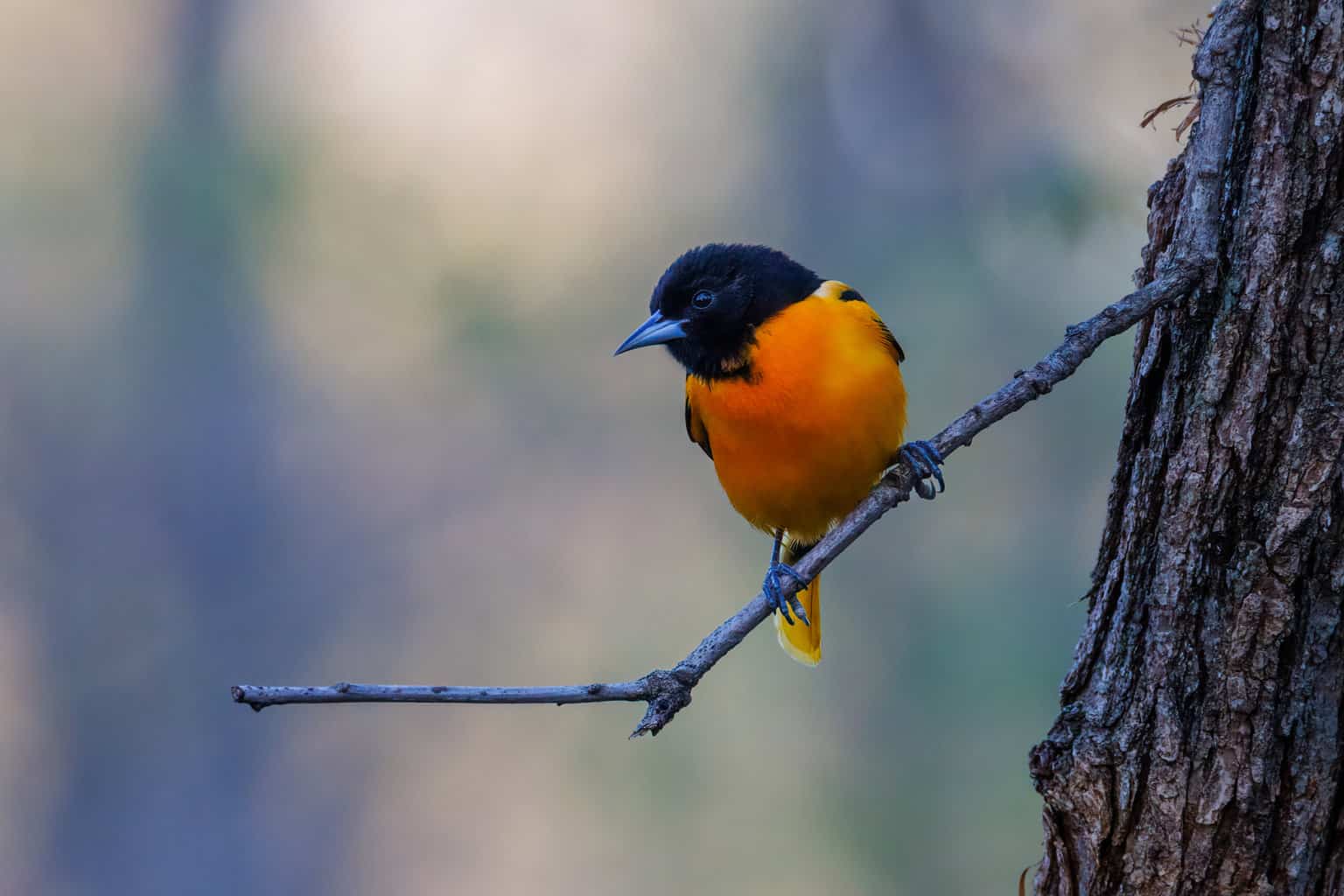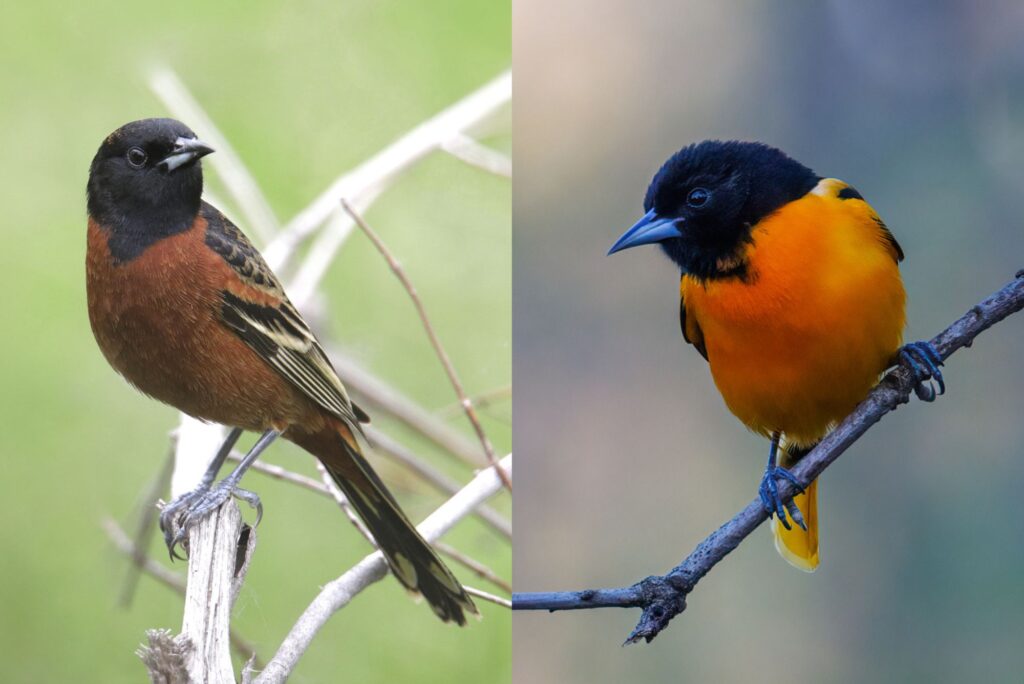Nine oriole species call continental North America home, but residents of the eastern United States are likely to see just two of them: Orchard and Baltimore orioles.
Baltimore orioles are the most common oriole east of the Great Plains, but how do you know if you’re seeing an Orchard Oriole or something else?
Where do Orchard and Baltimore Orioles Live?
The Baltimore oriole’s range is vast, from the Atlantic Coast to the western borders of the Great Plains states such as the Dakotas, Nebraska, and Kansas. In Canada, their range extends from Nova Scotia all the way to Alberta.

Baltimore orioles winter primarily in Central and South America and the Caribbean, although some will make their winter home in Florida.
The Orchard oriole’s range doesn’t extend as far north. While residents of northern Wisconsin, Minnesota, Michigan, and New York are likely familiar with Baltimore orioles, the Orchard oriole’s range extends to the lower parts of those states but not the entire state. Orchard orioles are not regular visitors to much of Maine, Vermont, New Hampshire, or Canada, either.
The Orchard oriole can also be found throughout Texas and Mexico during its breeding season, with a more condensed winter range in Central America than that of Baltimore Orioles.
Comparing Males is Easier than Females
Comparing male Baltimore and Orchard orioles is quite a bit easier than making a correct identification between females.
The main difference between male Orchard and Baltimore orioles is color. Baltimore orioles are a bright, striking orange color, while Orchard oriole males have chestnut brown plumage.
There is a subspecies of Orchard oriole, Fuertes’s Orchard oriole, that may appear a lighter orange, closer to the Baltimore oriole, but this subspecies is only found in Mexico.
Other than their color, the Orchard oriole is usually smaller than the Baltimore oriole. According to the Cornell Lab of Ornithology, the Orchard oriole is the smallest of the North American orioles, coming in at between 5.9 and 7.1 inches long and 0.6 to 1 ounce in weight.
For comparison, the average Baltimore oriole weighs between 1.1 and 1.4 ounces and measures from 6.7 to 7.5 inches long.
The Orchard oriole has a bill with a slight curve downward, although this is difficult to see at a distance.
Comparing Females and Juveniles
Ultimately, distinguishing between female Orchard and Baltimore orioles also comes down to color.
Female Orchard orioles are a dull yellow, whereas Baltimore females still have an orange tint to the plumage on their tails and breasts. Even their head is a bit more orange than the dull yellow of the Orchard oriole.
Like males, female Orchard orioles are smaller than Baltimore orioles and have a downward curving bill.
Immature birds look similar to adult females but with a large black throat patch. Young Baltimore orioles look similar to females as well.

Where to Look for Orchard and Baltimore Orioles
Baltimore orioles are frequent visitors to certain backyard feeders. While they don’t eat seeds like many other birds, a bowl of grape jelly or a sliced orange is often enough to draw orioles out of the trees if they’re nearby. You may even see them visiting your hummingbird feeders to feed on nectar.
When they’re not feeding on nectar and fruit, Baltimore orioles often feed on insects, which make up most of the Orchard oriole’s diet.
While they may occasionally be seen visiting fruit feeders, trees, or bushes, Orchard orioles meet their nutritional needs by plucking bugs from the trees.

Since most oriole sightings come at feeders for many American bird enthusiasts, it can be a bit more challenging to locate the smaller, less brightly colored Orchard oriole. But you might get lucky if you look up in the trees long enough. Some of their preferred habitats are along river edges, according to the Cornell Lab of Ornithology.
Look on the underside of tree branches, where Orchard orioles build their basket-like nests.
Frequently Asked Questions
Are Orchard orioles rare?
This depends on your location in North America. If you’re in certain pockets of the Great Plains or Gulf of Mexico coastal regions, they may be prevalent near you, but if you’re from a grassy farmland area or a northern state, they could be rarely spotted. They are an uncommon bird species according to the Minnesota Breeding Bird Atlas.
They form large groups before beginning their migration journeys, so if there are Orchard orioles near you, keep an eye out during these migration periods.
According to the Cornell Lab of Ornithology, they’re early migrants, leaving their breeding grounds as early as mid-July. So if you see large groups of black birds flocking up in mid to late summer, look closely to see if they’re Orchard orioles.
What Does an Orchard Oriole Look Like?
Orchard orioles are the smallest North American orioles, and males have a different color than what may first come to mind when you think of orioles.
A male Orchard oriole has a black head, throat, and back, with dark orange, chestnut-colored underside and wing patch.
Females are a yellow-green color with white wing bars, and immature males are yellow with a black throat patch.
Is There Another Bird that Looks like a Baltimore Oriole?
Nine main orioles have at least some part of their range in the Continental United States and Canada: Orchard, Baltimore, Hooded, Bullock’s, Spot-breasted, Streak-backed, Altamira, Audubon’s, and Scott’s. All of them are yellow or orange, although their patterns may differ from the Baltimore oriole.
At one point, Bullock’s oriole and Baltimore orioles were considered the same species, called the Northern oriole. They are now separate species, though they do hybridize where their range overlaps in the Great Plains.
The male Bullock’s oriole differs from male Baltimore orioles in that it has a larger white patch on its wings and a face that’s mostly orange, not black like the Baltimore oriole. Female Bullock’s orioles have a white belly area that Baltimore orioles do not.
Other orange or yellow birds that could be confused with a Baltimore oriole include Evening and Black-headed grosbeaks, robins, American redstarts, tanagers, meadowlarks, and Yellow-headed blackbirds.
What Bird Looks Like a Baltimore Oriole but is More Yellow?
Baltimore orioles have similar patterns to yellow orioles like Audubon’s orioles and Scott’s orioles, the latter in particular.
Scott’s orioles are natives of the American Southwest and Mexico, where they’re one of the earliest songbirds to fill the air with their song each morning. They have a black head, throat, and backside, with a yellow wing patch and undersides, similar to where orange would be seen on a Baltimore oriole.
However, the only time their range would typically ever overlap north of the Mexico-United States border would be during a Baltimore oriole’s migration through Texas.
The Yellow-headed blackbird also shares part of its range with the Baltimore oriole, although their patterns are quite different.

